There’s Zin. And then there’s Ridge Geyserville. [mature wine]
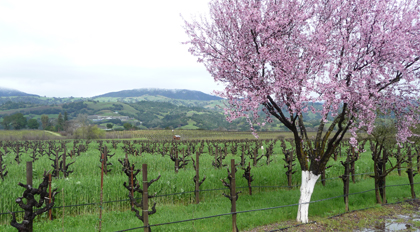
All too often, Zinfandel is a highway to a quick, cheap buzz. It’s often confused with white zin, rarely celebrated by wine writers aside from patriotic holidays, and it’s almost never aged.
However, there’s Zin, and then there’s a wine like Ridge Geyserville.
I had a chance to visit the property and talk with the cellar masters this past spring. Although I also tasted some spectacular wines of Monte Bello, I was looking forward to the tasting of old zinfandels dating back to 1973, including multiple pairs of Geyserville and Lytton Springs–could a Zinfandel age gracefully, I wondered?
The lay of the land
Ridge Vineyards, started 50 years ago in the Santa Cruz Mountains, has made Zinfandel wines since the early days. Although their first zinfandels came from the Monte Bello vineyards in Santa Cruz, the first Ridge Geyserville wines date from 1966. Today, the locus of Ridge’s single vineyard zinfandel production is their Lytton Springs Winery, north of Healdsburg in Sonoma. Although Paul Draper still holds the title of winemaker for all of Ridge, Eric Baugher makes the wines at the Monte Bello winery as well as the Geyserville wine. (John Olney heads the winemaking at the Lytton Springs winery–about seven other wines that have good distribution and other small-scale projects for their tantalizing ATP club.)
I arrived at the Geyserville vineyard in the afternoon on a March day when it had been raining constantly. The famed gravelly soils of the large vineyard couldn’t keep up, but the blooming trees lining the access road brought color the vineyard. So did the verdant cover crop–David Gates, head of Vineyard Operations, explained that they seasonally cultivate nitrogen rich cover crops such as legumes and then disc them into the ground to provide an organic boost for the soil. The vines are an assortment of varieties, co-planted in the vineyard here and there, and include mostly zinfandel but also carignane, petite sirah, and matarao (mourvedre). They are old–some as much as 130 years old–and stoic-looking as they are “head-trained,” or growing individually and not tethered together by a trellis. Here are a few photos:
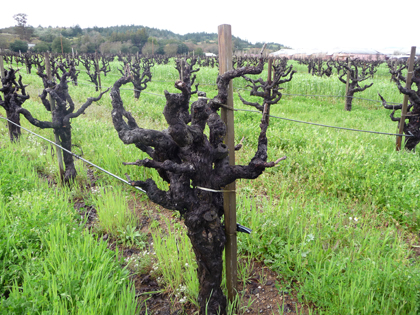
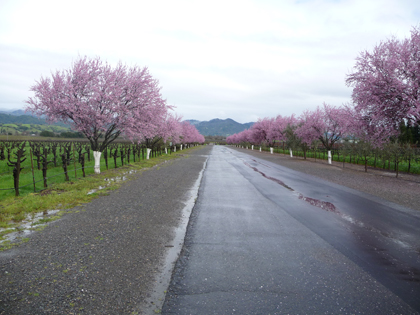

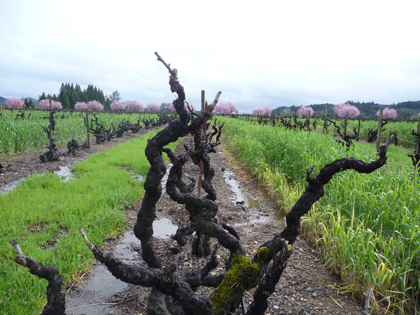
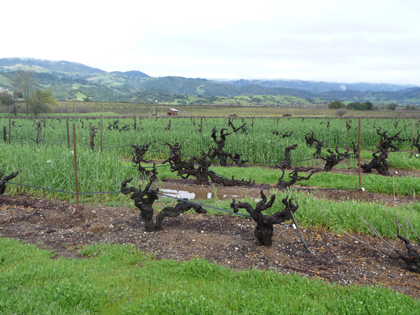
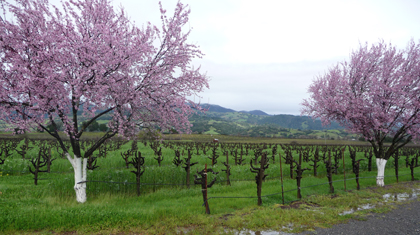
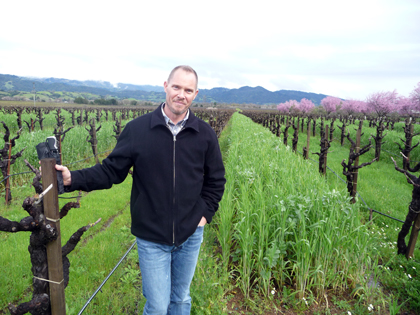
Eric Baugher, maker of Geyserville and Monte Bello
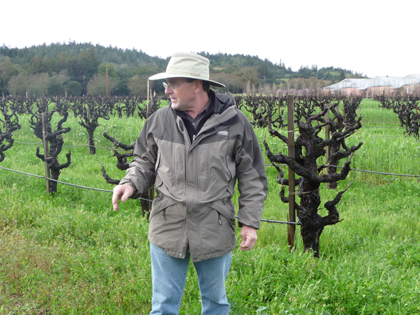
David Gates, head of Vineyard Operations
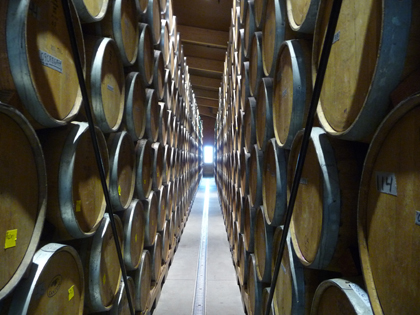
But back to the tasting table. The secret of Ridge Geyserville’s success may well be the vineyard, but it may also have to do with the blend, which usually is about three-quarters zinfandel, twenty percent carignane, adding acidity to the wine. (The balance of the blend consists of the aforementioned petite sirah and mataro, although they are not always in the final wine.) This stands in contras to the Ridge Lytton Springs, which tends to be darker and slightly more tannic and broad-shouldered thanks in part to about twenty percent petite sirah. Although the wines are always north of 14 percent alcohol, the wear it well, with balance and poise. The primary fermentation occurs with native yeasts. Typically, the wines are aged in about 20 percent new American oak barrels.
The 2008 Geyserville, translucent in the glass, exudes come-hither aromas of dark fruit, herbs, spice and cedar. Although it still as firm tannins on the finish, the complexity, intrigue and lively acidity were able to later convert Mrs. Vino, who usually runs the other way when zinfandel is mentioned. Although it can be consumed with pleasure during these winter months, there certainly are rewards for tucking it away and trying one of the other, more accessible Rdige zins, such as the new/old East Bench, in the interim.
The 2005 (“40th Anniversary”) is more accessible today and reveals the benefits of a few years aging as the tannins have softened, leaving behind a gorgeous, brambly zin with delicious aromatics of plum and spice. If you can still find this wine at retail, it is worth snapping up.
Turning to the older vintages, the 2001 and 1999 were still drinking very well, giving me cause for reconsidering the ageability of zin. But when we arrived at the 1988 Geyserville, zinfandel moved into a new category for me, not just a serious wine, but one built for the long haul. It’s a wine showing signs of maturity but very much alive, really delicious and exhibiting almost Rhone-like character. But the 1976 shattered any preconceptions that I had about the age-worthiness of a zinfandel-based wine. It was drinking supremely well; certainly the fruits of youth had fallen away but the acid and tannin carried it the distance. Moreover, all the parts in balance and I preferred it to the 1973 Lytton Springs, which I found a little too dominated tertiary aromas.
We concluded our tasting with the Geyserville Essence 2007, a late harvest zin, Ridge-style only available at the tasting room or mailing list. Paul Draper said “we harvested grapes, not raisins,” but they still came in loaded with sugars at 41 Brix. The slow fermentation stopped at 13.3% alcohol and they did not fortify the wine so that is where the alcohol remains. However, there is residual sugar, making it akin to a single-vineyard port but without the heat from the higher alcohol. A sweet and surprising way to finish the day of many revelations.
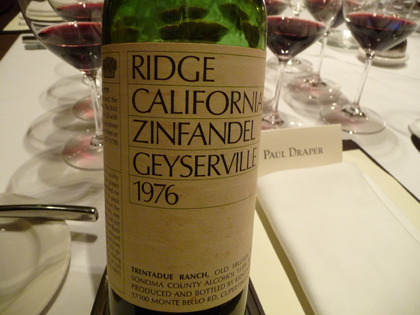
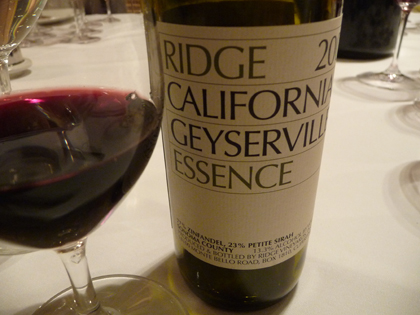




On December 4th, 2010 at 10:38 am ,CHRIS ROBINSON wrote:
I can’t believe it – two best kept secrets gone in one article. Those great Zins from Ridge revealed to everyone – and their age-ability. Some of these old Ridge Zins have been in a London friend’s wine cellar for many many years and I have had the pleasure of drinking them over many occasions. Have no qualms, these babies do well with some ageing – and without!!
On December 4th, 2010 at 11:29 am ,Jeff wrote:
I was lucky enough to taste seven 1990 California zinfandels recently. At least for that vintage, Lytton Springs was much livelier than Geyserville. Ravenswood Dickerson was the other wine with a lot still going on.
On December 4th, 2010 at 4:25 pm ,Christopher Watkins wrote:
What a wonderful post! Being a proud member of the Ridge Vineayards staff, I’m of course biased, but it was truly heartening to see this depth of appreciation so elegantly, eloquently, and thoroughly expressed. Cheers!
Regards,
Christopher Watkins
Tasting Room Manager
Ridge/Monte Bello
Host: “4488: A Ridge Blog”
On December 4th, 2010 at 5:52 pm ,Jon Troutman wrote:
Great notes here, Tyler. It’s a shame… zinfandel is definitely a wine that can hang out in the cellar for awhile, but too few producers make it with the balance that Ridge achieves. I can’t think of many zin producers from the late 90s / early ’00s that were making zin with the acid structure needed to age. It seems like lately a few names are popping up that craft zin with the same sensibility of Ridge (Bedrock comes to mind).
On December 5th, 2010 at 10:06 am ,Dave Erickson wrote:
I don’t think it’s any secret that Ridge makes zinfandel for grownups.
I love the look of old head-trained zin vines. I’m waiting for them to be featured as a Disturbing Element in a James Cameron film.
On December 5th, 2010 at 4:31 pm ,Stevie wrote:
I’ve never had aged zinfandel though after reading this I will look for it! Your photographs are beautiful! It looks like the trip was really fun and relaxing. I do drink a fair amount of zin. Much of it comes with screwtop caps. Do you think that would make a difference in aging? Also the zins that you’re writing about seem to have been blended wines. Do you think that a 100% zin would also age well?
On December 5th, 2010 at 11:25 pm ,Kevin wrote:
Visited the US for a meeting last month, and was delighted to find a nearly complete range of the Ridge Zins at the local retailer. Unfortunately, the duty-free allowance flying back into Australia is only three bottles, so had to choose two of the Geyserville 2007’s for laying down, and an East Bench 2006 to drink soon. Glad to hear it was a good choice. Great photos too, by the way.
On December 5th, 2010 at 11:30 pm ,Vitabella » Blog Archive Vitabella Wine Daily Gossip - Luxury Wine - Marketing Strategy - Edition December 6, 2010 wrote:
[…] art, finance and many others. Wine of Argentina: The world in reverse? (Buenos Aires Herald) Ridge California: There’s Zin. And then there’s Ridge Geyserville. (Dr Vino) History of New Zealand Wines…Saluting Selaks: Let's drink to the 'Dallies' (Southland […]
On December 6th, 2010 at 2:29 pm ,Chris Parente wrote:
Really nice post. I’m a Zin fan and will look for some of these. Recently picked up a Ridge Bordeaux blend highly recommended by Calvert Woodley in DC — looking forward to enjoying that one.
On December 6th, 2010 at 6:26 pm ,Keith Marton wrote:
As you suggest, Ridge is the exception, not the rule, when it comes to ageability of Zins. And, it may well be the blend of Zin plus others that does the trick–plus Ridge always makes such balanced wines.
I’ve been buying (and keeping) Ridge wines for nearly 45 years and prefer to drink almost anything they make when it has at least 10 years on it.
On December 7th, 2010 at 3:10 pm ,Which affordable wines can age? How can I be a sommelier? [new blogs] | Dr Vino's wine blog wrote:
[…] add a plug for chenin blanc, especially leading producers of Vouvray, such as Foreau and Huet, or Ridge zins. Hit the comments with your thoughts on this $64 (for two or more bottles) […]
On December 18th, 2010 at 1:29 am ,Delayed Gratification, or If Life is a Cabernet, Then Sex is a Zin! | oenophiliacs wrote:
[…] the blow of yet another birthday. To wash down Thanksgiving turkey, we’ve got some hearty Ridge Zinfandel on the block. New Year’s comes in with the miraculous muted bang of a venerable Yquem. And so […]
On December 27th, 2010 at 8:01 pm ,CB wrote:
i had the Ridge Geyserville with Christmas dinner and was impressed…so impressed that i bought the 9 remaining bottles at a local wine merchant’s store. after reading through the article and subsequent comments, i’m wondering just what to do next-tuck away all, most or some of the 9 bottles of RG….
On January 1st, 2011 at 5:19 pm ,John of Portland wrote:
I couldn’t agree more. I am slowly creeping my way through my stash of 1990s Geyservilles (not to mention many other old zins I got through Ridge’s mailing list) and these are serious, well-made, ageworthy wines. No, they aren’t spicy, snappy, briar-y young zins. They are complex, soft, multilayered wines. Erickson, above, called these ‘zinfandels for grownups’, and this is absolutely correct. Ridge is doing its usual beautiful work. It endures.
On January 2nd, 2011 at 8:28 pm ,Chris Parente wrote:
A bit off topic, but I was disappointed in the Bordeaux blend, a 2007 Santa Cruz Mountains Estate. Not bad but not worth the $30+ price.
Next time I’ll try the Zin!